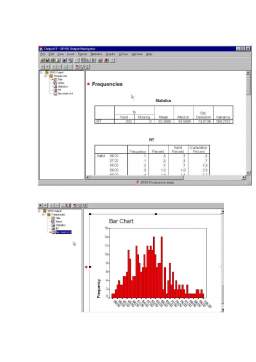Extras din curs
This tutorial is a brief look at what SPSS for Windows is capable of doing. Examples will come from Statistical Methods for Psychology by David C. Howell. It is not our intention to teach you about statistics in this tutorial. For that you should rely on your classes in statistics and/or a good textbook. If you're a novice this tutorial should give you a feel for the programme and how to navigate through the many options. Beyond that, the SPSS Help Files should be used as a resource. Further, SPSS sells a number of very good manuals.
The Basics
SPSS for Windows has the same general look a feel of most other programmes for Windows. Virtually anything statistic that you wish to perform can be accomplished in combination with pointing and clicking on the menus and various interactive dialog boxes. You may have noted that the examples in the Howell textbook are performed/analyzed via code. That is, SPSS, like many other packages, can be accessed by programming short scripts, instead of pointing and clicking. We will not cover any programming in this tutorial.
Presumeably, SPSS is already installed on your computer. If you don't have a shortcut on your desktop go to the [Start => Programs] menu and start the package by clicking on the SPSS icon.
Before proceeding I should say a few words about a very simple convention that will be used in this tutorial. In this point and click environment one often has to navigate through many layers of menu items before encountering the required option. In the above paragraph the prescribed task was to locate the SPSS icon in the [Start] menu structure. To get to that icon, one must first click on [Start] then move the pointer to the [Programs] options, before locating the SPSS icon. This sequence of events can be conveyed by typing [Start => Programs] . That is, one must move from the outer layer of the menu structure to some inner layer in sequence....
Now, back to the tutorial.
Once you've clicked on the SPSS icon a new window will appear on the screen. The appearance is that of a standard programme for windows with a spreadsheet-like interface.
As you can see, there are a number of menu options relating to statistics, on the menu bar. There are also shortcut icons on the toolbar. These serve as quick access to often used options. Holding your mouse over one of these icons for a second or two will result in a short function description for that icon. The current display is that of an empty data sheet. Clearly, data can either be entered manually, or it can be read from an existing data file.
Browsing the file menu, below, reveals nothing too surprising - many of the options are familiar. Although, the details are specific to SPSS. For example, the [New] option is used to specify the type of window to open. The various options, under the [New] heading are,
• [Data] Default window with a blank data sheet ready for analyses
• [Syntax] One can write scripts like those present in the Howell text, instead of using the menus. See the SPSS manuals for help on this topic.
• [Output] Whenever a procedure is run, the out is directed to a separate window. One can also have multiple [Output] windows open to organize the various analyses that might be conducted. Later, these results can be saved and/or printed.
• [Script] This window provides the opportunity to write fullblown programmes, in a BASIC-like language. These programmes have access to functions that make up SPSS. With such access it is possible to write user-defined procedures - those not part of SPSS - by taking advantage of the SPSS functions. Again, this is beyond the scope of this tutorial.
Preview document
Conținut arhivă zip
- SPSS for Windows - Tutorial.doc











































